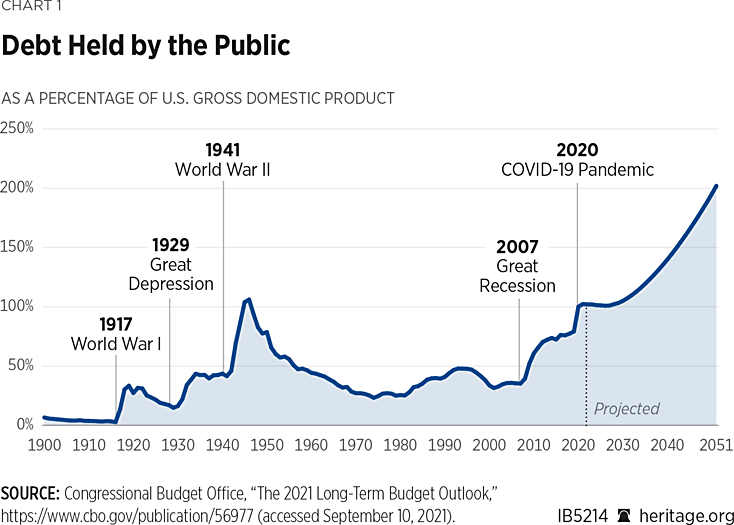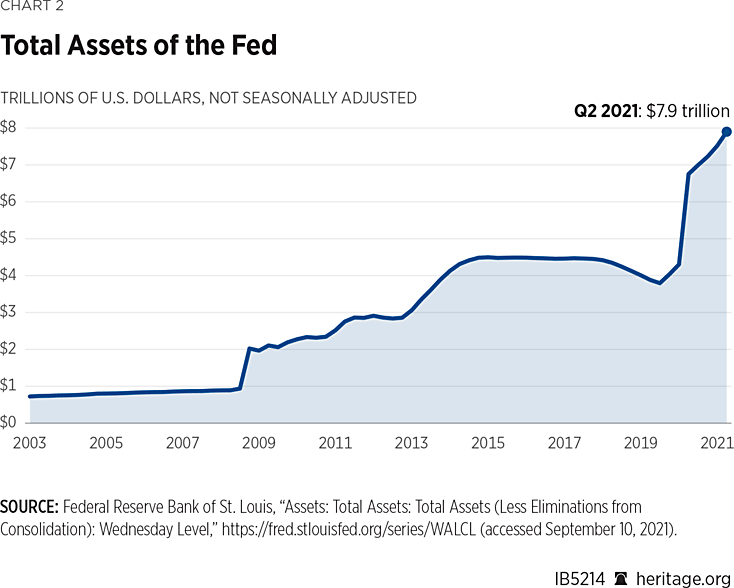In just one generation, the national debt has soared from $5.2 trillion to more than $28.4 trillion.REF This does not just represent a future burden on the country. The debt is only a piece of the total portion of our economy consumed by the government and is used to regulate the lives of Americans. It is an assault on American citizens’ basic rights.
The debt limit, suspended since enactment of the Bipartisan Budget Act in August 2019, was re-imposed on August 1, 2021.REF But Treasury Secretary Janet Yellen has asked Congress to suspend the debt limit yet again.REF The looming end of fiscal year (FY) 2021 at the end of September, and expected exhaustion of extraordinary measures, will likely put pressure on Congress to tie a debt-limit suspension to a funding bill at the end of September.REF
President Joe Biden’s FY 2022 budget alone proposed $6.4 trillion in new spending, more than the inflation-adjusted cost of World War II.REF In addition to the $1.9 trillion American Rescue Plan enacted in March,REF the Senate has passed a $1.1 trillion infrastructure bill that would add hundreds of billions in deficit spending. Congress has also adopted a budget resolution that includes partisan reconciliation instructions paving the way for at least $1.75 trillion more in federal debt.REF
Simply suspending the debt limit without significant policy reforms would only serve to finance trillions in new federal spending, supporting an agenda meant to reshape the American economy and permanently expand government control over many aspects of peoples’ lives.REF Conservatives in Congress should not give President Biden a blank check.

Past fiscally responsible reforms, such as enactment of the Budget Control Act (BCA) of 2011, have come from principled conservatives fighting blank-check suspensions of the debt limit.REF
Any increase of the debt limit must be accompanied by the following four conditions. Congress must:
- Enact mechanisms to control the growth rate of federal spending;
- Install a revenue cap that ensures that balance is not achieved on the backs of taxpayers;
- Prohibit suspensions of the debt limit and allow the debt limit to increase only by specific dollar amounts; and
- Call on the Federal Reserve to provide transparency about its unprecedented financing of the federal debt.
The Threat of a “Clean” Debt-Limit Increase: A Large and Compounding National Debt
A “clean” suspension or increase of the debt limit would simply facilitate the current fiscal trend of the federal government and exacerbate its threat to the nation’s financial stability. It is hard to underestimate the threat posed by the runaway trajectory of the compounding national debt. The Congressional Budget Office (CBO) projects that in just one generation net interest costs will consume over 6.7 percent of the economy.REF That is slightly more than the annual production value of all agricultural, forestry, fishing, mining, oil extraction, and construction industries in the United States.REF That is of the volume of the annual work and productivity of the American people that will be consumed simply to service the federal government’s debt.
As that figure grows exponentially, it is a plain to see the inescapable truth that all federal debt eventually results in exponentially increased tax burdens. However, the debt is not only some far away disaster waiting to burden future generations. It is a weight dragging down the nation today. The $28.4 trillion national debt represents roughly one-fifth of American household assets, locked away in the various pet projects and programs under the direction of the federal government.REF
Before the government can spend a dollar, it must first take or borrow that dollar from someone who earned it, removing money from the private sector and putting it under the control of government politicians and bureaucrats. Whereas the credit worthiness of an individual or company is based on merit, the credit worthiness of a government is based on its power to tax someone in the future.
As such, the national debt is a representation of a portion of what the government has taken from Americans and repurposed to meet the desires of federal bureaucrats and politicians.REF The misallocation of such a large portion of the nation’s assets stunts wage and job growth today.REF Without this debt, Americans would have a more prosperous society that would offer more economic mobility for everyone.
Congress should prevent a clean suspension or increase of the debt limit. A debt-limit increase devoid of meaningful reforms would exacerbate these burdens and continue to stunt the nation.
Fiscal Controls Needed to Restrain Spending and Prevent Tax Hikes
It is vital to remember that all government spending is ultimately financed by dollars removed from the economy first. Achieving a balanced budget through tax increases simply alters how the government takes these dollars. Increasing deficits and increasing taxes both work to rob American families and to stifle economic growth. Reducing government spending is the only solution to rising deficits that protects prosperity.
The first cornerstone of these fiscal controls needs to be a revenue cap that limits the percentage of the economy that the government can take. Congress should then pair this cap with reforms that address all federal spending and bring growth rates down to a sustainable level that is below gross domestic product (GDP) growth.
Congress has a variety of options from which to choose in order to create these spending controls.REF PAYGO and similar fiscal rules are often circumvented and should be replaced and consolidated into a robust mechanism that would truly hold Congress accountable for all newly proposed spending. Debt-to-GDP targets could be used to ensure a stable trajectory, and Congress could mirror systems designed to ensure balance across periods of time to account for the business cycle.REF
Though there are many congressional rules and procedures, and many fiscal limits that can be added to federal law, the key is assembling a package that Congress will hold to and not undercut with exemptions or carve-outs in the future. For example, the BCA was amended four times to increase spending caps by hundreds of billions of dollars, undercutting the very purpose of the BCA.REF Though congressional rules and federal law may be amended easily, the fiscal trajectory, if unaltered, will not be so accommodating.
Congress should also borrow from numerous frameworks, such as The Heritage Foundation’s Blueprint for Balance, Blueprint for a Responsible Post Covid-19 Budget, and the Republican Study Committee’s annual budget, to implement specific reforms that would properly limit spending growth.REF
What is of paramount importance is that Congress require any increase of the debt limit to be paired with reforms that will ensure long-term stability and a limited government.REF If Congress does not act soon to reduce spending in a thoughtful manner, the economic realities of the fiscal trajectory will do so in a painful and uncontrollable manner.
Prohibit Blank-Check Suspensions of the National Debt Limit
Since 2013, Congress has not technically voted to increase the debt limit. Instead, it has voted eight times to suspend it altogether.REF When Congress suspends the debt limit, the limit ceases to exist during the period of the suspension. When the period of the suspension is over, the debt limit is reinstated at the level of debt on the day that the limit is re-imposed. This practice means that during the period of the suspension there is no limit on federal borrowing, and the federal government has an effective blank check against the national credit card.REF
Suspensions of the debt limit are often tucked into the back corner of a “must pass bill,” such as an appropriations omnibus or continuing resolution. By suspending the debt limit entirely, Congress grants a blank check during the period of the suspension. This now common practice undermines the entire purpose of the debt limit. Conservatives in Congress should work to ensure that the debt limit is never again suspended and is only increased by specific dollar amounts.
One legislative procedure that has been considered to increase the debt limit is the budget reconciliation process, which allows certain legislation to be considered under an expedited process and passed by the Senate with a simple majority vote bypassing the possibility of a filibuster. Though no Senate precedent has been established on whether reconciliation can be used to suspend the debt limit, the traditional understanding is that reconciliation can only be used to increase the limit by a specific dollar amount. The statutory language concerning the use of reconciliation in this manner specifically provides for the alteration of the amount of the limit.REF Each of the four times that reconciliation was used to increase the debt limit was a specific dollar increase.REF
A particularly concerning proposal would allow President Biden to suspend the debt limit via executive action. Congressional leadership would then use a show vote on a resolution of disapproval to give cover to certain Members. The leadership could offer this vote to vulnerable Members while knowing that the resolution would not receive the two-thirds vote required (veto-proof majority) to block President Biden’s order.REF Such proposed further delegations of congressional Article I authority would only make it harder to enact the meaningful reforms required to curb the growth of government.
Blocking debt-limit suspensions, requiring that future increases consist of specific dollar amounts, would hold the government accountable. Specific dollar increases of the debt limit allow the limit to serve as a meaningful cap on attempts to create new expensive programs and serve as a check on each vote to increase deficit spending. Conversely, allowing another suspension of the debt limit would remove a large roadblock to the trillions of dollars of new spending that President Biden and his congressional allies are calling for.
The Fed’s Quiet Work to Cover the Debt
The Fed is charged with managing the national money supply “so as to promote effectively the goals of maximum employment, stable prices, and moderate long-term interest rates.”REF The Fed was not intended to indulge large federal deficits to finance endless expansions of government.
However, just since the start of the pandemic, the Fed has lent almost $23,000 per American household to the federal Treasury.REF In fact, of the roughly $5.2 trillion of new federal debt since then, $2.8 trillion of it, a whopping 54 percent, was purchased by the Fed.REF
Just since the start of the pandemic, the Fed has given the federal Treasury sufficient purchasing power to have bought, in full, Amazon, Tesla, and Walmart, with change to spare.REF Since 2008, as the Fed has shifted its role, it has increased its asset holdings from under $900 billion to more than $8.2 trillion today.REF

It is time for Congress to call for full transparency from the Fed on this matter. Congress should require the Fed to regularly and publicly report on its plans to finance portions of new federal debt and on which consequences could arise from such action.
As the Fed has shifted its role, Congress must ensure that the American people can clearly see and understand the impacts of such an unprecedented policy.
Conclusion
As it seems likely that Congress will be asked soon to vote yet again on the debt limit, the question will be if it is in vain. Many will call for the debt limit to be suspended once again to provide a blank check for an ever-growing government. Another suspension of the debt limit, devoid of meaningful reforms, would simply facilitate this expansion of government and a march toward increasing fiscal instability.
If Congress can cap federal revenues, implement spending controls that put the federal budget on a path to solvency, prevent another blank-check suspension of the debt limit, and shed light on the Fed’s financing of the debt, then, perhaps for the first time in more than a decade, voting on the debt limit will not be in vain.
Richard Stern is Senior Policy Analyst in the Grover M. Hermann Center for the Federal Budget, of the Institute for Economic Freedom, at The Heritage Foundation.



